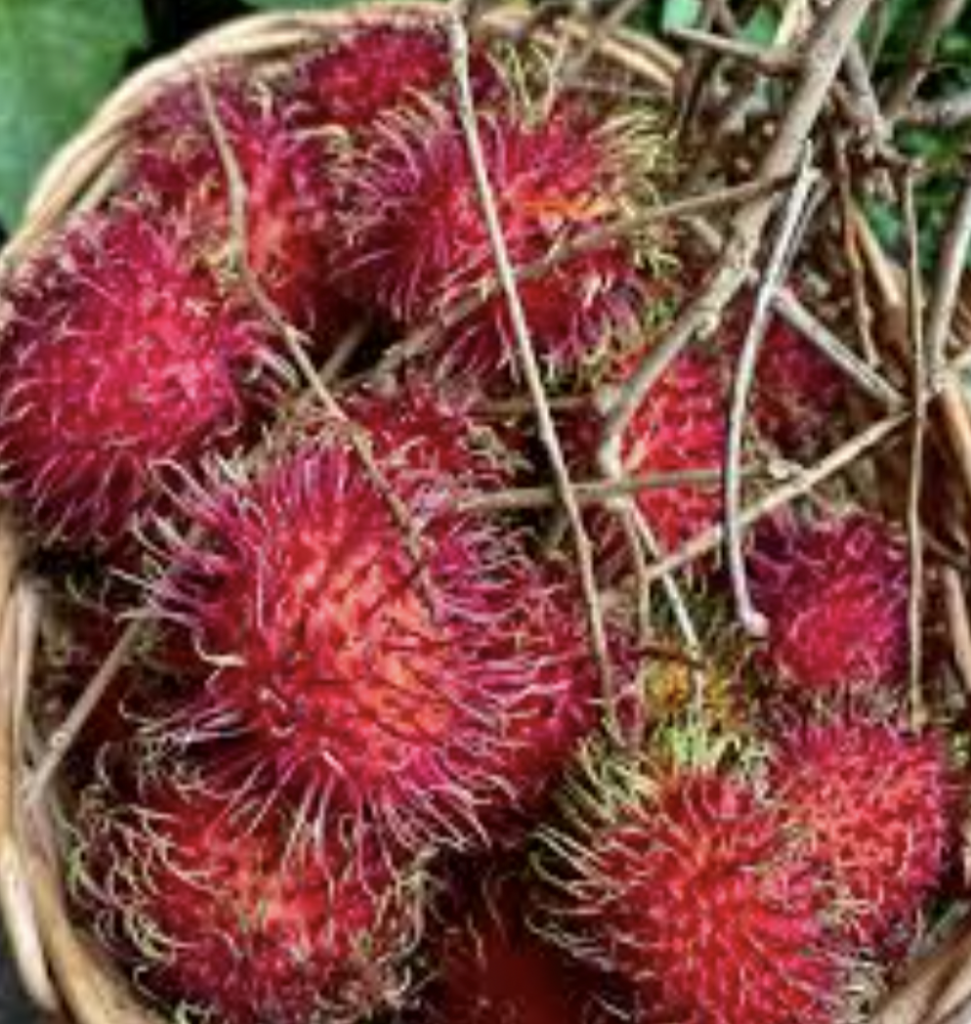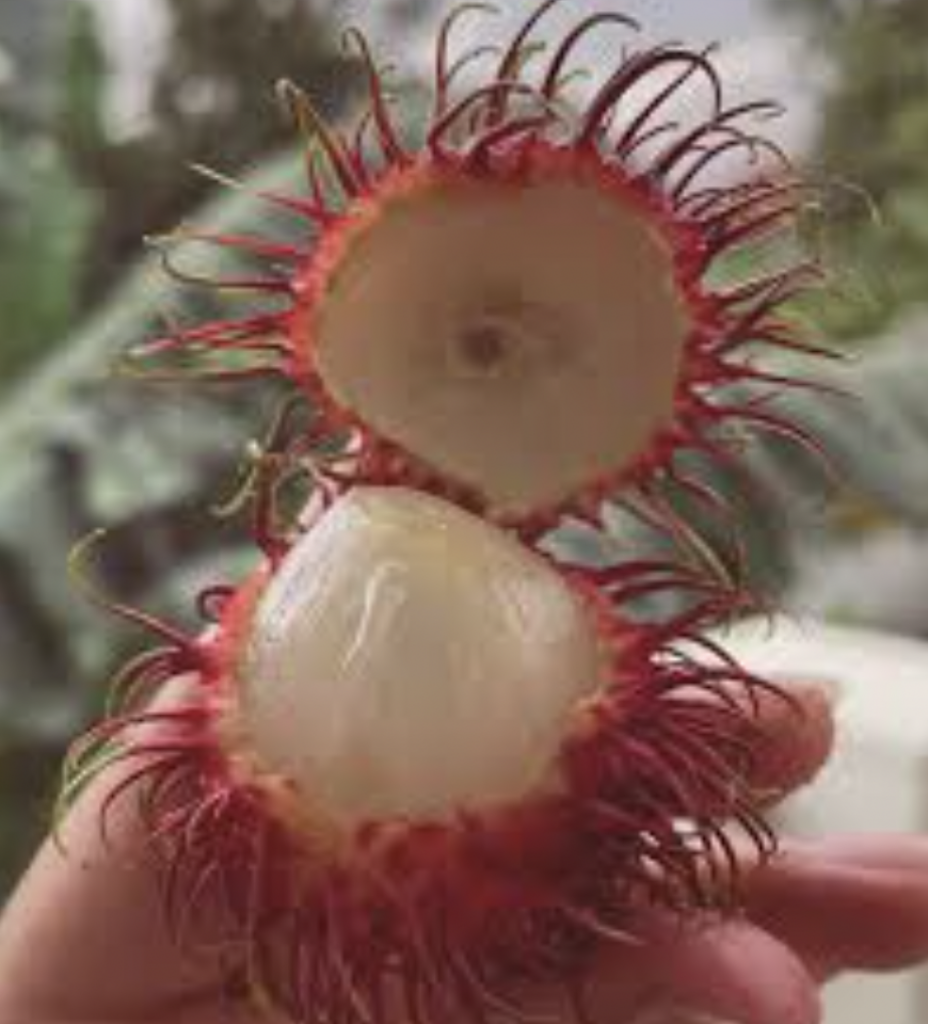The Rambutan (Nephelium Lappaceum) is a tropical fruit native to South-East Asia, known for its unique appearance and sweet, juicy flesh. Often described as looking like a sea urchin or a hairy lychee, the Rambutan is as intriguing to look at as it is delicious to eat.
Origins and Botanical Background
The name “Rambutan” is derived from the Malay and Indonesian word rambut, meaning “hair”, a reference to the fruit’s hairy red and green spines. Native to the Malay-Indonesian region and other regions of tropical South-East Asia, the Rambutan belongs to the Sapindaceae family, which also
includes lychee, longan, and pulasan.
Rambutan trees can grow up to 20 meters tall and thrive in warm, humid climates. They produce fruit twice a year, typically during the rainy seasons. Each fruit is about the size of a golf ball and is covered with pliable, hair-like spines. The outer skin is easily peeled to reveal a translucent, whitish flesh that surrounds a single seed.


Cultivation and Global Spread
While originally confined to South-East Asia, Rambutan cultivation has expanded to tropical regions
around the world, including:
- Thailand, Malaysia, and Indonesia – The primary producers and exporters.
- Sri Lanka and India – Increasing cultivation due to favourable climate.
- Central America and the Caribbean – particularly in Costa Rica and Honduras.
- Hawaii and other parts of the Pacific – as a niche fruit crop.
Rambutan trees prefer rich, well-drained soil and require a consistent supply of moisture. They are typically grown from seed or grafted to produce higher-quality fruit.
Nutritional Profile
Rambutan is not only a tasty fruit but also a nutritious one. A 100-gram serving of Rambutan provides:
- Calories: Approximately 68
- Carbohydrates: 16–18 grams
- Vitamin C: About 40% of the recommended daily intake
- Fibre: 0.9 grams
- Iron: 0.3 mg
The fruit also contains small amounts of calcium, potassium, magnesium, and B vitamins such as niacin and riboflavin.
Health Benefits:
- Boosts Immunity – High vitamin C content strengthens the immune system.
- Aids Digestion – Dietary fibre promotes healthy digestion and prevents constipation.
- Improves Skin Health – Antioxidants help reduce oxidative stress.
- Supports Weight Management – Low in calories and fat, making it a healthy snack option.
Culinary Uses
Rambutan is typically eaten fresh, but it is also used in a variety of culinary applications:
- Fresh Fruit Platters – Peeled and served chilled.
- Salads and Desserts – Adds a tropical twist to fruit salads, yogurt, and ice cream.
- Canned or Preserved – Often canned in syrup for export or used in sweet dishes.
- Beverages – Juiced or infused in cocktails and smoothies.
While the seed inside is not edible raw due to certain toxins, it can be roasted and eaten in some cultures after proper preparation.

Cultural and Economic Importance
In many South-East Asian countries, Rambutan is a culturally significant fruit. It is commonly sold at local markets and roadside stalls during the fruiting season. Festivals and fairs often feature Rambutan tasting events, showcasing different varieties and hybrids.
Economically, Rambutan plays a role in the livelihoods of small-scale farmers and exporters. With rising global interest in exotic fruits, Rambutan has seen increased demand in North America, Europe, and other non-tropical regions.
How to Choose and Store Rambutan
When selecting Rambutans:
- Look for bright red or yellow skin (depending on the variety).
- Spines should be firm and slightly greenish.
- Avoid fruits with blackened or overly soft areas.
Store Rambutans in a cool place or refrigerate them for up to a week. For longer storage, they can be peeled and frozen. Watch how to cut open and eat a Rambutan.
Final Thoughts
The Rambutan is a fascinating fruit that brings together beauty, flavour, and nutrition in one compact package. Whether enjoyed fresh or incorporated into creative dishes, it offers a delightful experience for fruit lovers. As the world becomes more adventurous with its palate, the Rambutan is gaining the recognition it deserves beyond its native regions.
You could try Pomelo (Giant Citrus Fruit), Jackfruit (World’s Largest Fruit), Snake Fruit, Durian (King
of Fruits), or Mangosteen (Queen of Fruits) on YPT’s Tours of South-East Asia (click here for tours).





